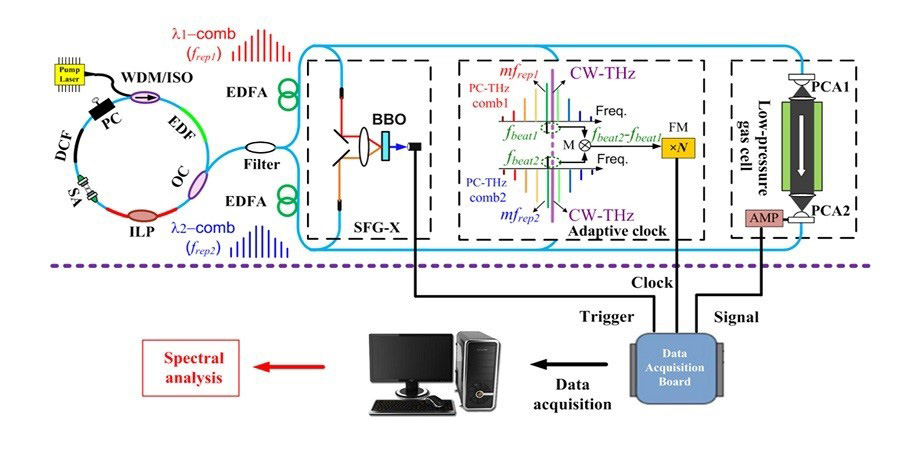Versatile, High-Performance THz Spectroscopy for Gas Detection

Hazardous gas leaks. Toxic gas clouds. Detection can prevent disasters and save countless lives. For real-time sensing of target gasses, terahertz (THz) spectroscopy is considered an effective technique, yet despite promising developments since the 1980s, a form of THz spectroscopy suitable for such practical applications has remained elusive—until now.
A Terahertz View of Gas Molecules
Other methods do exist. Gas chromatography has high sensitivity, but the measurement is not real-time and the method has many limitations, such as the need for sample preprocessing. Infrared absorption spectroscopy is rapid, but light-scattering due to ambient aerosols—smoke, soot, dust, mist, fog, haze, fumes, etc.—hinders its performance.
Uniquely, THz spectroscopy has the potential to provide crucial information in a spectral region inaccessible to optical and microwave technologies. The terahertz region of the spectrum is a characteristic frequency band where a significant part of the molecular structure of a target gas can be seen. Instead of the intermolecular vibration spectrum observed in the infrared region, rotational transitions of polar gas molecules including volatile organic compound gases can be seen, which enables high selectivity and sensitivity. Plus, the relationship between the wavelength of THz radiation and the size of minute particles means far less susceptibility to optical scattering caused by aerosols.
THz, Meet the Dual-Comb Fiber Laser
To discern a target gas, any spectroscopic technique used must have high spectral resolution, high spectral accuracy, and broad spectral coverage in the THz region. Conventional THz spectroscopic techniques cannot quite meet all requirements, but THz dual-comb spectroscopy (THz-DCS) can achieve all of that and rapidly. Still, THz-DCS for practical use is hampered by the need for a pair of complex, expensive repetition-rate-stabilized lasers as optical frequency comb sources. Recently, a single-cavity dual-comb fiber laser has appeared as a new way to reduce the expense and complexity, as a single laser without need for stabilization control. However, the residual timing jitter of the laser hindered spectroscopic performance.
Jitter-Free Dual-Comb THz Spectroscopy
Professor Yasui's group at Tokushima University, Japan, collaborating with Professor Zheng's group at Beihang University, China, combined a single-cavity dual-comb fiber laser with an adaptive sampling method to achieve the "ultimate form" of THz spectroscopy—jitter-free. Their report, published in the peer-reviewed journal Advanced Photonics, demonstrates the method with low-pressure spectroscopy of acetonitrile gas with Doppler-limit-approaching absorption features. They report a remarkably narrow absorption linewidth (25 MHz)—the first achieved with a dual-comb fiber laser. The team's adaptive sampling method reduces system complexity, lowers barriers for practical use, and accelerates real-world applications. This THz spectroscopic technique will contribute to monitoring air pollution and may extend to broader areas of application.

Mode-resolved absorption spectra of CH3CN and air with a total pressure of 360 Pa within the frequency range of (a) 0.2 to 0.72 THz and (b) around 0.3310 THz. (c1)-(c6) Mode-resolved absorption characterization of CH3CN around 0.3310 THz.
Read the open-access article in Advanced Photonics: Chen et al., "Adaptive-sampling near-Doppler-limited terahertz dual-comb spectroscopy with a free-running single-cavity fiber laser," Adv. Photon. 2(3), 036004, doi: 10.1117/1.AP.2.3.036004.
| Enjoy this article? Get similar news in your inbox |
|



